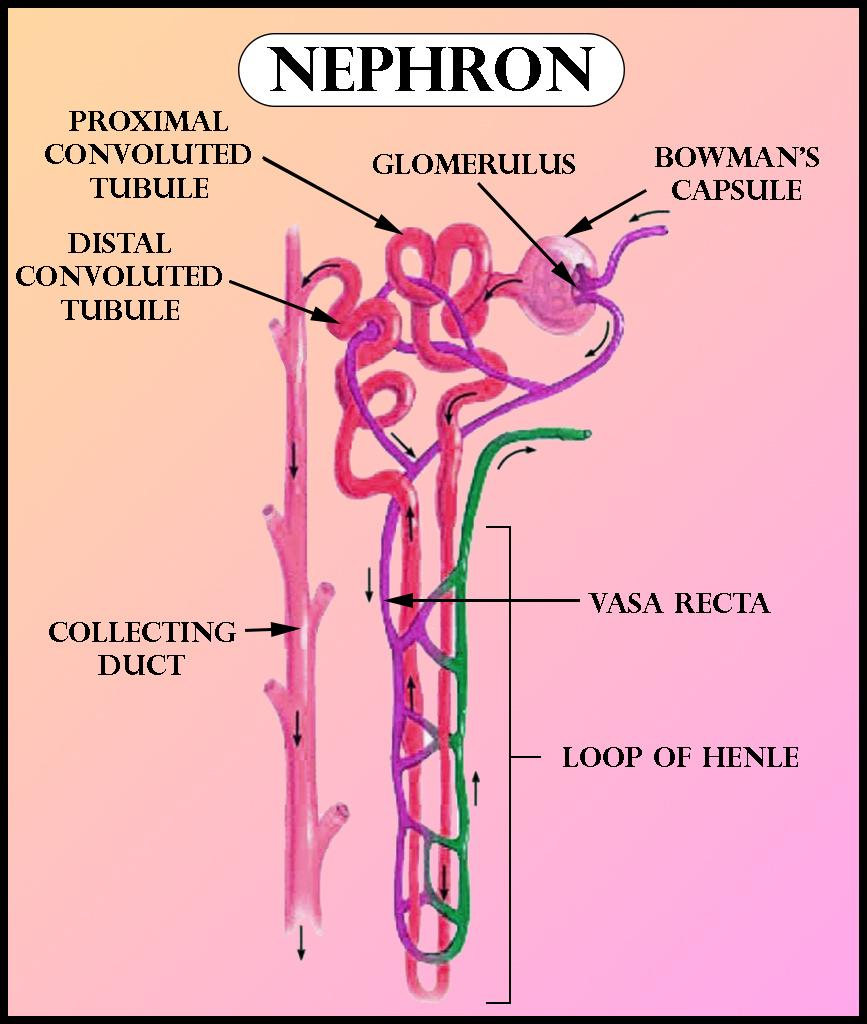
Distal convoluted tubule is lined with
(a) Simple cuboidal epithelium
(b) Ciliated squamous epithelium
(c) Pseudostratified epithelium
(d) None of the above
Answer
492.9k+ views
Hint: Distal convoluted tubule is a part of the nephron which is the structural and functional unit of the kidney. A distal convoluted tubule has the main role in conditional reabsorption of ions and is lined by specialized flat-cells.
Complete answer:
Distal convoluted tubules are lined with simple cuboidal epithelium. The simple cuboidal epithelium consists of a single layer of cube-like cells that provide protection and differentiates to perform secretory functions also. They also function in absorption. As distal convoluted epithelium has a function of conditional reabsorption so simple cuboidal epithelium helps in the absorption of sodium ions and water.

Additional Information: - Nephron in the kidney consists of 4 regions- Bowman's capsule, proximal convoluted tubule (PCT), a loop of Henle, and distal convoluted tubule (DCT).
- Bowman's capsule has the function of ultrafiltration which is the step in urine formation, proximal convoluted tubule is the region where 70-80% of electrolytes and water are reabsorbed. The loop of Henle has two parts-ascending and descending limbs. The ascending limb is impermeable to water and concentrates the filtrate whereas the descending limb is impermeable to electrolytes and thus dilutes the filtrate.
- Distal convoluted tubules conditionally reabsorbs water and sodium ions. Aldosterone hormone reabsorbs sodium ions actively and ADH reabsorbs water passively. DCT also reabsorbs bicarbonate.
So, the correct answer is `simple cuboidal epithelium`.
Note: Nephrons are of two types-juxtamedullary nephrons and cortical nephrons. Juxtamedullary nephrons run deep into the medulla and cortical nephrons run only a small part in the medulla. Juxtamedullary nephrons are only 15% of the total and cortical nephrons are about 85% of the total.
Complete answer:
Distal convoluted tubules are lined with simple cuboidal epithelium. The simple cuboidal epithelium consists of a single layer of cube-like cells that provide protection and differentiates to perform secretory functions also. They also function in absorption. As distal convoluted epithelium has a function of conditional reabsorption so simple cuboidal epithelium helps in the absorption of sodium ions and water.

Additional Information: - Nephron in the kidney consists of 4 regions- Bowman's capsule, proximal convoluted tubule (PCT), a loop of Henle, and distal convoluted tubule (DCT).
- Bowman's capsule has the function of ultrafiltration which is the step in urine formation, proximal convoluted tubule is the region where 70-80% of electrolytes and water are reabsorbed. The loop of Henle has two parts-ascending and descending limbs. The ascending limb is impermeable to water and concentrates the filtrate whereas the descending limb is impermeable to electrolytes and thus dilutes the filtrate.
- Distal convoluted tubules conditionally reabsorbs water and sodium ions. Aldosterone hormone reabsorbs sodium ions actively and ADH reabsorbs water passively. DCT also reabsorbs bicarbonate.
So, the correct answer is `simple cuboidal epithelium`.
Note: Nephrons are of two types-juxtamedullary nephrons and cortical nephrons. Juxtamedullary nephrons run deep into the medulla and cortical nephrons run only a small part in the medulla. Juxtamedullary nephrons are only 15% of the total and cortical nephrons are about 85% of the total.
Latest Vedantu courses for you
Grade 11 Science PCM | CBSE | SCHOOL | English
CBSE (2025-26)
School Full course for CBSE students
₹41,848 per year
EMI starts from ₹3,487.34 per month
Recently Updated Pages
Master Class 11 Economics: Engaging Questions & Answers for Success

Master Class 11 Business Studies: Engaging Questions & Answers for Success

Master Class 11 Accountancy: Engaging Questions & Answers for Success

Master Class 11 English: Engaging Questions & Answers for Success

Master Class 11 Computer Science: Engaging Questions & Answers for Success

Master Class 11 Maths: Engaging Questions & Answers for Success

Trending doubts
State and prove Bernoullis theorem class 11 physics CBSE

1 ton equals to A 100 kg B 1000 kg C 10 kg D 10000 class 11 physics CBSE

State the laws of reflection of light

One Metric ton is equal to kg A 10000 B 1000 C 100 class 11 physics CBSE

1 Quintal is equal to a 110 kg b 10 kg c 100kg d 1000 class 11 physics CBSE

Difference Between Prokaryotic Cells and Eukaryotic Cells




